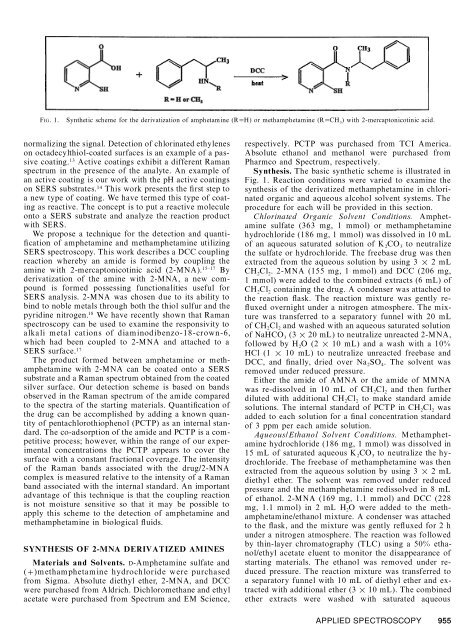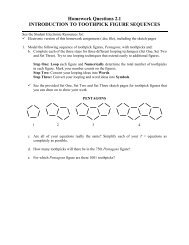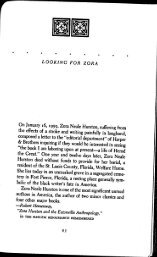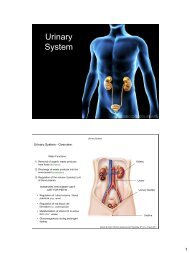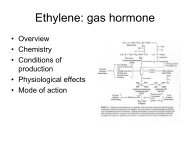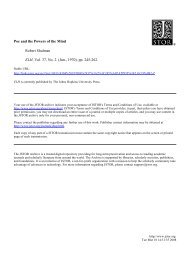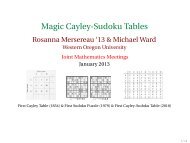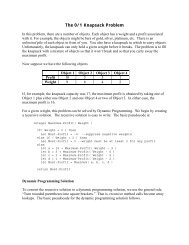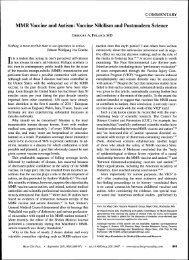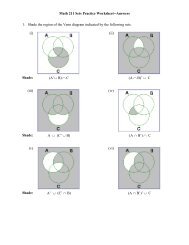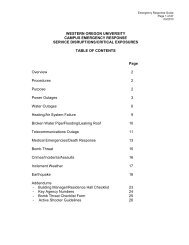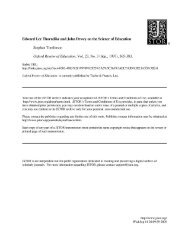Surface-Enhanced Raman Scattering Detection of Amphetamine ...
Surface-Enhanced Raman Scattering Detection of Amphetamine ...
Surface-Enhanced Raman Scattering Detection of Amphetamine ...
You also want an ePaper? Increase the reach of your titles
YUMPU automatically turns print PDFs into web optimized ePapers that Google loves.
FIG. 1. Synthetic scheme for the derivatization <strong>of</strong> amphetamine (R5 H) or methamphetamine (R5 CH 3) with 2-mercaptonicotinic acid.<br />
normalizing the signal. <strong>Detection</strong> <strong>of</strong> chlorinated ethylenes<br />
on octadecylthiol-coated surfaces is an example <strong>of</strong> a passive<br />
coating. 13 Active coatings exhibit a different <strong>Raman</strong><br />
spectrum in the presence <strong>of</strong> the analyte. An example <strong>of</strong><br />
an active coating is our work with the pH active coatings<br />
on SERS substrates. 14 This work presents the ® rst step to<br />
a new type <strong>of</strong> coating. We have termed this type <strong>of</strong> coating<br />
as reactive. The concept is to put a reactive molecule<br />
onto a SERS substrate and analyze the reaction product<br />
with SERS.<br />
We propose a technique for the detection and quanti-<br />
® cation <strong>of</strong> amphetamine and methamphetamine utilizing<br />
SERS spectroscopy. This work describes a DCC coupling<br />
reaction whereby an amide is formed by coupling the<br />
amine with 2-mercaptonicotinic acid (2-MNA). 15±17 By<br />
derivatization <strong>of</strong> the amine with 2-MNA, a new compound<br />
is formed possessing functionalities useful for<br />
SERS analysis. 2-MNA was chosen due to its ability to<br />
bind to noble metals through both the thiol sulfur and the<br />
pyridine nitrogen. 18 We have recently shown that <strong>Raman</strong><br />
spectroscopy can be used to examine the responsivity to<br />
alkali m etal cations <strong>of</strong> diam inodibenzo-18-crown-6,<br />
which had been coupled to 2-MNA and attached to a<br />
SERS surface. 17<br />
The product formed between amphetamine or methamphetamine<br />
with 2-MNA can be coated onto a SERS<br />
substrate and a <strong>Raman</strong> spectrum obtained from the coated<br />
silver surface. Our detection scheme is based on bands<br />
observed in the <strong>Raman</strong> spectrum <strong>of</strong> the amide compared<br />
to the spectra <strong>of</strong> the starting materials. Quanti® cation <strong>of</strong><br />
the drug can be accomplished by adding a known quantity<br />
<strong>of</strong> pentachlorothiophenol (PCTP) as an internal standard.<br />
The co-adsorption <strong>of</strong> the amide and PCTP is a competitive<br />
process; however, within the range <strong>of</strong> our experimental<br />
concentrations the PCTP appears to cover the<br />
surface with a constant fractional coverage. The intensity<br />
<strong>of</strong> the <strong>Raman</strong> bands associated with the drug/2-MNA<br />
complex is measured relative to the intensity <strong>of</strong> a <strong>Raman</strong><br />
band associated with the internal standard. An important<br />
advantage <strong>of</strong> this technique is that the coupling reaction<br />
is not moisture sensitive so that it may be possible to<br />
apply this scheme to the detection <strong>of</strong> amphetamine and<br />
methamphetamine in biological ¯ uids.<br />
SYNTHESIS OF 2-MNA DERIVATIZED AMINES<br />
Materials and Solvents. D-<strong>Amphetamine</strong> sulfate and<br />
(1 )m etham phetam ine hydrochloride w ere purchased<br />
from Sigma. Absolute diethyl ether, 2-MNA, and DCC<br />
were purchased from Aldrich. Dichloromethane and ethyl<br />
acetate were purchased from Spectrum and EM Science,<br />
respectively. PCTP was purchased from TCI America.<br />
Absolute ethanol and methanol were purchased from<br />
Pharmco and Spectrum, respectively.<br />
Synthesis. The basic synthetic scheme is illustrated in<br />
Fig. 1. Reaction conditions were varied to examine the<br />
synthesis <strong>of</strong> the derivatized methamphetamine in chlorinated<br />
organic and aqueous alcohol solvent systems. The<br />
procedure for each will be provided in this section.<br />
Chlorinated Organic Solvent Conditions. <strong>Amphetamine</strong><br />
sulfate (363 mg, 1 mmol) or methamphetamine<br />
hydrochloride (186 mg, 1 mmol) was dissolved in 10 mL<br />
<strong>of</strong> an aqueous saturated solution <strong>of</strong> K 2CO 3 to neutralize<br />
the sulfate or hydrochloride. The freebase drug was then<br />
extracted from the aqueous solution by using 3 3 2 mL<br />
CH 2Cl 2. 2-MNA (155 mg, 1 mmol) and DCC (206 mg,<br />
1 mmol) were added to the combined extracts (6 mL) <strong>of</strong><br />
CH 2Cl 2 containing the drug. A condenser was attached to<br />
the reaction ¯ ask. The reaction mixture was gently re-<br />
¯ uxed overnight under a nitrogen atmosphere. The mixture<br />
was transferred to a separatory funnel with 20 mL<br />
<strong>of</strong> CH 2Cl 2 and washed with an aqueous saturated solution<br />
<strong>of</strong> NaHCO 3 (3 3 20 mL) to neutralize unreacted 2-MNA,<br />
followed by H 2O (2 3 10 mL) and a wash with a 10%<br />
HCl (1 3 10 mL) to neutralize unreacted freebase and<br />
DCC, and ® nally, dried over Na 2SO 4. The solvent was<br />
removed under reduced pressure.<br />
Either the amide <strong>of</strong> AMNA or the amide <strong>of</strong> MMNA<br />
was re-dissolved in 10 mL <strong>of</strong> CH 2Cl 2 and then further<br />
diluted with additional CH 2Cl 2 to make standard amide<br />
solutions. The internal standard <strong>of</strong> PCTP in CH 2Cl 2 was<br />
added to each solution for a ® nal concentration standard<br />
<strong>of</strong> 3 ppm per each amide solution.<br />
Aqueous/Ethanol Solvent Conditions. Methamphetamine<br />
hydrochloride (186 mg, 1 mmol) was dissolved in<br />
15 mL <strong>of</strong> saturated aqueous K 2CO 3 to neutralize the hydrochloride.<br />
The freebase <strong>of</strong> methamphetamine was then<br />
extracted from the aqueous solution by using 3 3 2 mL<br />
diethyl ether. The solvent was removed under reduced<br />
pressure and the methamphetamine redissolved in 8 mL<br />
<strong>of</strong> ethanol. 2-MNA (169 mg, 1.1 mmol) and DCC (228<br />
mg, 1.1 mmol) in 2 mL H 2O were added to the methamphetamine/ethanol<br />
mixture. A condenser was attached<br />
to the ¯ ask, and the mixture was gently re¯ uxed for 2 h<br />
under a nitrogen atmosphere. The reaction was followed<br />
by thin-layer chromatography (TLC) using a 50% ethanol/ethyl<br />
acetate eluent to monitor the disappearance <strong>of</strong><br />
starting materials. The ethanol was removed under reduced<br />
pressure. The reaction mixture was transferred to<br />
a separatory funnel with 10 mL <strong>of</strong> diethyl ether and extracted<br />
with additional ether (3 3 10 mL). The combined<br />
ether extracts were washed with saturated aqueous<br />
APPLIED SPECTROSCOPY 955


